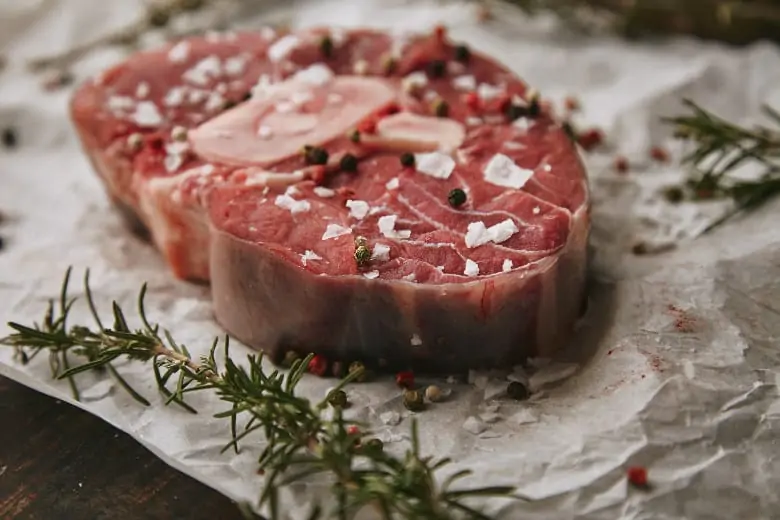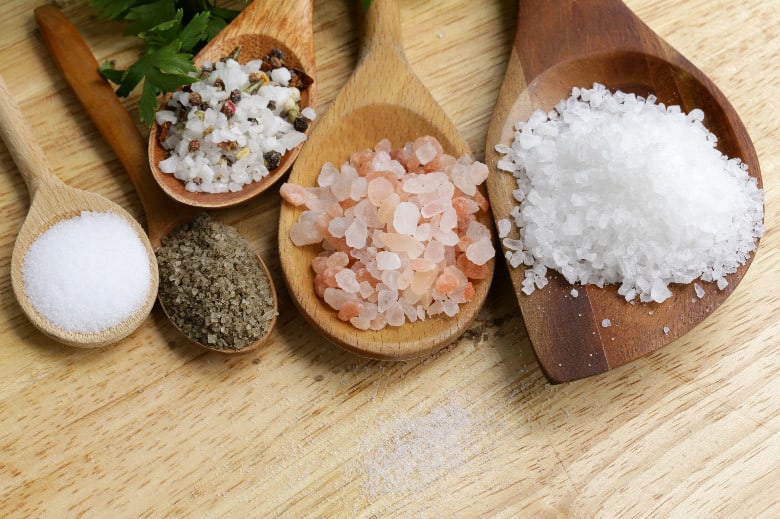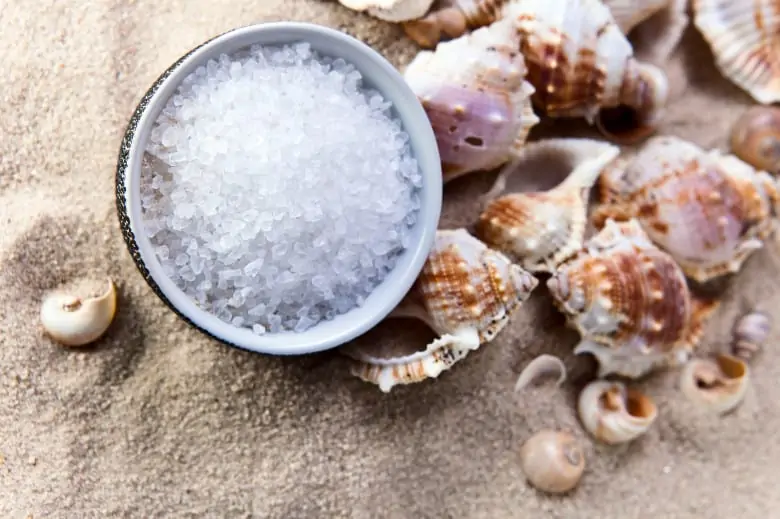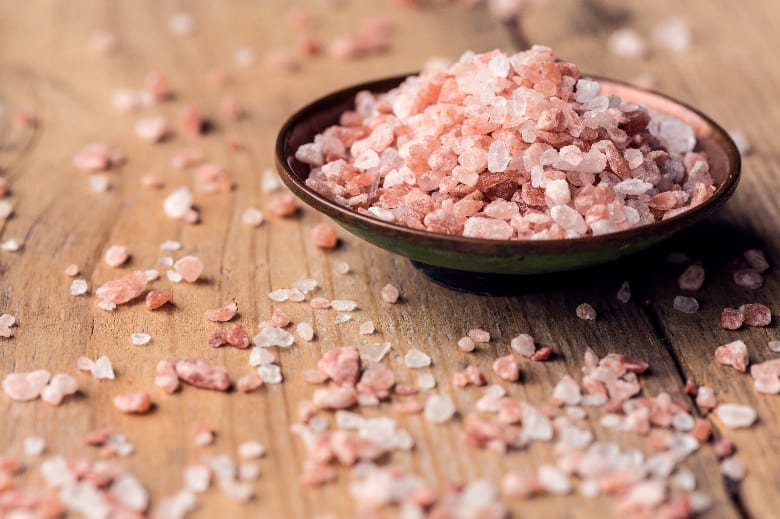Kosher salt is just a fancy salt, right? Well not exactly.
There are numerous different kinds of salt you’ll find in the culinary world. For instance, there’s pink Himalayan salt, sea salt, pickling salt, and the one most of us are familiar with, regular table salt. Then, there’s kosher salt.
I’ve had countless conversations with friends, foodies, and acquaintances that thought kosher salt just meant salt certified by the Jewish faith. While they’re not wrong, there’s more to kosher salt than that.
I’ll walk you through what you need to know about kosher salt in addition to some common alternative options.
Related: Check out our other guides for more useful tips.
What is Kosher Salt?
Grab a pinch of kosher salt and rub it between your fingers. Notice anything? Likely, the first thing you’ll notice is kosher salt has a coarse texture.
Yet, those large salt crystals have the same chemical composition as your common non-iodized table salt. Which, if you paid attention in chemistry, is nothing other than a bunch of bonded ions. Sodium chloride (NaCl) formed by a strong ionic bond to be exact.
How Did Kosher Salt Get Its Name?
Ok, enough with the chemistry lecture. Let’s move on to history. See, those larger salt crystals are the basis for how kosher salt was named. Which, if you didn’t guess already, has something to do with Kashrut, the Jewish dietary laws.
Long ago it was discovered that the larger flakes of kosher salt are an incredible cooking mechanism for drawing blood from meat. Sprinkle some on a bloody steak and you’ll see what I mean.

Kashrut forbids eating meat with excess blood. Kosher salt was used as a prime culinary ingredient for koshering meat. But, that doesn’t mean the salt itself is kosher.
To clarify, there are two types of kosher salt. The first is non-certified kosher salt. The second is certified kosher salt.
Both undergo the same salt mining process. What’s different about the latter is every step of the manufacturing process adheres to strict guidelines following Jewish traditions. By doing so, a Jewish institution can then certify that salt as kosher.
Where Does Kosher Salt Come From?
First, let’s talk about salt. Salt is a naturally occurring mineral. It’s an excellent source of the essential nutrient sodium which helps regulate the human body.
There are two methods by which we derive salt from the earth. The first is by evaporating saltwater. The second is by mining salt deposits on land.
Now, on to kosher salt. Kosher salt is mainly derived from salt mines. These mines are the result of seawater that evaporated and left behind salt deposits. However, this doesn’t mean that all kosher salt will have the same size and shape.
Like all-purpose flour, kosher salt may vary by brand. You may find one brand has different-sized crystals than the other. Perhaps even a different taste. And taste, after all, is really what we’re after.
What Is Kosher Salt Good For?
Kosher salt is an ingredient like any other. So what makes it better than, say, iodized salt or sea salt? It all has to do with purpose, consistency, and flavor.
I like to think of salt as I think of tomatoes. Cherry tomatoes are great in salads. Beefsteak tomatoes are a must for burgers. And for salsa? Don’t even get me started.
Like tomatoes, each salt has a specific purpose. The coarse-grain crystals of kosher salt make it ideal for seasoning meat and veggies. Compare it to table salt and you’ll have a much cleaner taste.
The reason why has to do with iodine which I’ll talk about in a bit. But for now, let’s just say iodine has a specific taste. A taste that can come off as being metallic.
Kosher salt doesn’t include any additives. This means no iodine or anti-caking agents. The larger flakes are easy to see which can prevent over-salting. Those larger flakes also dissolve well.
For all these reasons, I recommend using kosher salt for preserving or seasoning. You can also use it for baking but keep in mind you’ll likely need to make some adjustments.
This is because most recipes calling for salt just mean table salt. However, table salt is denser so you’ll need to account for this in your recipe.
Other Common Varieties of Salt
Here’s a look at some common culinary salts and their best use in the kitchen.

Table Salt
The most common form of salt used by far is table salt. Table salt is highly affordable and versatile.
You can use it to boil pasta water, season food, bake, clean cast iron skillets, and even gargle as a mouth rinse.
The downside to table salt is it’s highly processed and contains impurities. Table salt also often has additives such as anti-caking agents. This makes it easier to shake a salt shaker without all those fine-grained salt crystals clumping up.
Another common additive is iodine. This is good for your health but not so good for flavor. More on this in a moment.
Scoop up a teaspoon and you’ll notice table salt is very dense. It’s also very fine. When using table salt, it’s recommended that you season with caution and don’t go overboard.
Use it to bake some blueberry muffins or season a hearty soup. Always use what the recipe calls for or less. It’s also always a good idea to taste as you go. The last thing you want is overly salted food.
Sea Salt
The moment I started using sea salt to flavor my food, I noticed a huge difference in taste. Sea salt has a bolder flavor than table salt. For this reason, it’s great as a finishing salt.
I love adding it to my oven-roasted potatoes as it does well to compliment those carb-laden spuds. It’s also divine when sprinkled on top of caramel chocolates. However, a pinch can go a long way so don’t sprinkle too generously.

Unlike other salts, sea salt comes as either fine or coarse. It’s also less refined than other salts adding to the purity of flavor. The reason why has to do with the processing method which involves evaporating seawater.
But, there is some growing controversy over the use of sea salt. As microplastics enter our watersheds, there’s concern about these tiny particles ending up in commercially produced sea salt, among other things.
Himalayan Salt
If there were one salt that visually stands out among the rest, it would be Himalayan salt. This salt is denoted by larger, oversized salt crystals in gorgeous hues. The most popular being pink.
However, not all Himalayan salt is pink. From white to black, Himalayan salt comes in a variety of colors.
What causes the colors have to do with iron content in addition to other minerals. The more iron the salt has, the redder in color it will be.

Himalayan salt is believed to be one of the purest salts on the market. The clean flavor and large flakes make it ideal as a finishing salt.
One study has shown Pink Himalayan salt possesses more essential minerals and less sodium than white table salt. However, the amount of Himalayan salt you would need to consume far outweighs the nutritional benefits.
Iodized Salt
So what’s all this business about iodized salt? To understand this, we need to go back to class.
Iodine is an essential nutrient that keeps your metabolism and central nervous system running properly. It’s vital to your thyroid, specifically with producing thyroid hormones. Too much or too little can cause serious health problems.
Before the 1920s, iodine deficiency was a huge problem throughout the USA. Ever see pictures of bulging goiters on necks? Yeah, it was like that. In fact, regions of high iodine deficiency were known as the “goiter belt”.
That’s when research turned to action. Scientists had previously been studying the connection between iodine and goiters. After promising results, it became a common practice to fortify salt with iodine.
Nowadays, it’s estimated that about 120 countries even make it mandatory to include iodine in salt. While it’s not mandatory in the USA, it’s readily available at markets as iodized table salt. Some manufacturers even make iodized sea salt.
So unless you’re eating massive amounts of shrimp and seaweed, it’s probably a good idea to add a touch of iodized salt to your food, but sparingly.
Related: How To Choose The Best Oil To Cook With For Every Dish
Conclusion
Of the numerous types of salt, kosher salt is one you should add to your culinary arsenal. The coarse flakes are phenomenal for seasoning, especially meats.
And it’s not the only salt I recommend adding to your spice rack. Other salts such as pink Himalayan and sea salt can add a burst of flavor at just the right salinity.
Despite the type, all salt can greatly enhance a dish when seasoned right. Add a pinch at a time and taste as you go. With a bit of experimentation, you’ll find the right salt at the right ratio.
